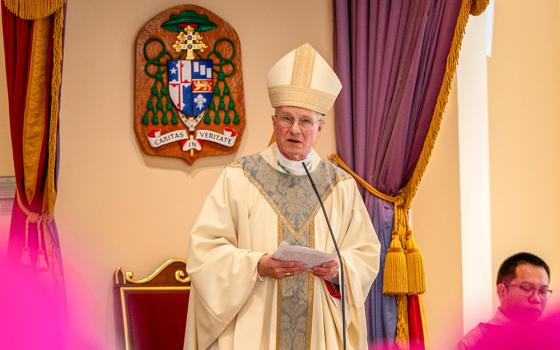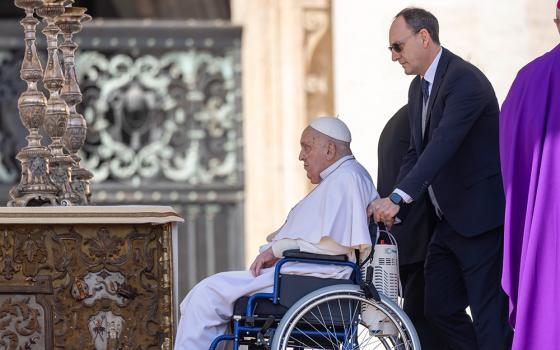
A drone view shows debris surrounding some homes left standing in Horseshoe Beach, Fla., Sept. 28, 2024, after Hurricane Helene swept through the area. Helene caused at least 52 deaths and billions of dollars of destruction across a wide swath of the southeastern U.S. as it raced through, and more than 3 million customers went into the weekend without any power and amid a continued threat of flooding. (OSV News/Marco Bello, Reuters)
Four Florida dioceses with substantial coastal exposure along the Gulf of Mexico have been assessing significant flood damage while activating regional distribution centers following Hurricane Helene.
Hurricane Helene garnered Category 4 major hurricane status just before landfall along the Florida Panhandle Sept 26. The 500-mile-wide storm then carried catastrophic flooding and destruction through Georgia, North Carolina, South Carolina and Virginia.
By midday Sept. 30, CNN was reporting that at least 115 people have died across six states and officials fear the death toll will rise. "Many more remain missing, perhaps unable to leave their location or unable to contact family where communications infrastructure is in shreds," CNN said.
Although coastal areas of the Diocese of Pensacola-Tallahassee took a direct hit in terms of the hurricane's landfall, many areas in the diocese and around the South suffered from the heavy storm surge and rain.
"Other Catholic Charities CEO's have been texting me and offering help and sending stuff — I do feel like maybe we did get hit the hardest," said Maggie Rogers, executive director of Catholic Charities of the Diocese of St. Petersburg.
"I moved to Florida in 2002 and I can tell you this is the most water I have ever seen from any storm," Rogers told OSV News, adding that one county in the diocese alone was reporting hundreds of homeowners are displaced following Helene.
"In the rainy season roads here flood so easily with normal rain so having a hurricane pushing in that water I knew it was going to be devastating, but maybe not quite this devastating," she added.
Catholic Charities of the Diocese of St. Petersburg had evacuated clients from several residential programs and low-income housing facilities prior to the storm, and some of them will be in temporary living arrangements while repairs are made following flood related damages. In addition, some handful of her own staff are reporting significant damage to their homes and automobiles.
"Now it will be down to how we help our community in long-term recovery. In a market where there is already not nearly enough affordable housing it will be an exponential need," Rogers said. "The calls are still coming in because many people are just getting back to their homes so I think the number is going to increase."
The diocese has identified Our Lady Queen of Peace in New Port Richey north of the St. Petersburg region as a preliminary regional distribution center for that region.
Helene is being described as one of the largest storms in the Gulf of Mexico in the last century, with a wind field spanning roughly the distance between Indianapolis and Washington and with maximum sustained winds estimated at 140 mph at its highest point.
In Tallahassee, where it was feared the hurricane might have its greatest impact, Gabe Tischler, emergency management specialist for Catholic Charities of Florida Inc. said he spent the Sept. 28-29 weekend connecting emergency resources and supplies with requests for water, food, generators and more for placement throughout central and northwest Florida.
The dioceses of St. Augustine, Venice, Pensacola-Tallahassee and St. Augustine were all reporting hurricane related impacts.
Over the weekend Tischler said he was alerted to an elderly couple living in a rural North Florida in need of electricity for the husband's oxygen machine and who were now facing two weeks of power outage.
Ironically, they were already living in temporary housing following last year's Hurricane Idalia when Helene struck and left them in a new crisis. Tischler was able to relocate a generator and have it delivered to the family through his Catholic Charities network of state and nonprofit emergency partners. The family are now back in their temporary housing with electricity for their oxygen machine.
Advertisement
In Florida, each of the seven dioceses have a mutual aid agreement to assist one another following a crisis.
"We have eight truckloads of water sent out, eight truckloads of MREs and we are currently doing mobile distribution into heavy hit areas along the coast — accomplished through a partnership with sisters organizations, mostly voluntary based nonprofits, all relatively new and which have made excellent partnerships with Catholic Charities," Tischler said.
"I am working with the state on getting housing for dairy farms where housing is damaged for the workers," he added, noting that the rural areas are often overlooked by media coverage from the big population centers following storms.
At Catholic Charities USA, Katie Oldaker, senior director of disaster strategy, told OSV last Friday that her agency's network of agencies will be looking at past and future creative ways to leverage resources and assist far flung communities, especially following Helene, which has prompted calls for assistance in places such as Knoxville, Tennessee; Charlotte, North Carolina, areas of Georgia, to name a few.
"We think we will have (distribution) hubs in Florida, Raleigh NC and probably in south Mississippi or Louisiana," Oldaker said.
"We don't think anyone expected the level of destruction and levels of rain — including the flooding in the St. Petersburg area where they are a little surprised," she added.
"In the initial reports we are seeing more damage associated with the eastern bands of the hurricane which were carrying a ton of water.
"A lot of innovative ideas that will be coming out of this disaster, and this one is pretty widespread, and we are looking at doing the hub and spoke model of (resource sharing and distribution)."
The Catholic Charities USA staff will also be looking for ways to remotely alleviate some of the emergency response and case management workload on local chapters that will be overwhelmed in the months ahead.
"This is definitely not a sprint, this is a marathon for long term recovery. A lot of disaster work can take two, three and five years, so it's good to have a solid plan."
Many people are in shock now and grieving from such devastating loss, including some 15 Florida Gulf Coast churches with either flooding or roofing damage, according to Teresa Peterson, director of diocesan information and communications for the Diocese of St. Petersburg.
Based on initial assessments, seven schools have had some sort of damage in that diocese, she added.
Even St. Petersburg Bishop Gregory L. Parks had to leave his residence and take up temporary shelter elsewhere as a result of Helene.
"Our leadership is also working to help file insurance and FEMA claims, avert scammers, and provide assistance to clergy, religious and employees," Peterson said.
"Parishes that can are helping one another. One parish is on stand-by to be a longer-term Red Cross emergency shelter and another hosted a neighborhood clean-up," she said. "Others are finding out what the needs are and trying to meet the needs."



